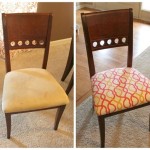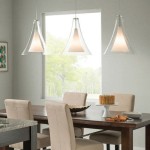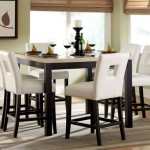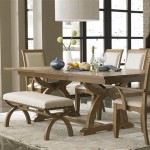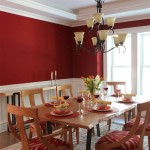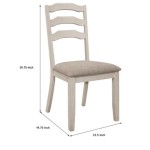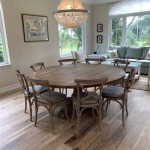Window Treatment For Dining Room
The dining room serves as a focal point for gatherings, meals, and celebratory events within a home. The selection of appropriate window treatments can significantly influence the ambiance, functionality, and aesthetic value of this space. Choosing the right window coverings requires careful consideration of factors such as natural light control, privacy, thermal insulation, and overall design harmony. This article examines various window treatment options for dining rooms, highlighting their individual characteristics and suitability for different needs and preferences.
Light Control Considerations
One of the primary functions of window treatments is to manage the amount of natural light entering a room. In a dining room, the desired level of light can vary depending on the time of day, the purpose of the room at that time, and the personal preferences of the occupants. Harsh sunlight can cause glare on tables and screens, fade furniture, and create discomfort. Conversely, insufficient light can make the room feel gloomy and unwelcoming.
Several window treatment options offer varying degrees of light control. Sheer curtains or shades allow diffused light to filter into the room, creating a soft and airy atmosphere. These are suitable for dining rooms where privacy is not a major concern and a bright, cheerful ambiance is desired. However, they offer minimal control over direct sunlight and may not be adequate in south-facing rooms or during peak sunlight hours.
Venetian blinds, mini blinds, and vertical blinds provide greater control over light levels. The adjustable slats allow for precise manipulation of incoming light, enabling users to direct light upward, downward, or completely block it out. These options are particularly useful for dining rooms that experience varying levels of sunlight throughout the day. However, it's important to note that even when closed, these blinds may not provide complete blackout, and some light seepage may occur.
Roller shades, particularly those made with blackout fabrics, offer excellent light control and privacy. When fully lowered, they can effectively block out all light, creating a dark and intimate setting. This makes them ideal for dining rooms used for evening meals or for those who prefer a darker ambiance. However, when raised, they offer no light control, and the window is fully exposed. Dual roller shades, which combine a sheer and a blackout shade on the same mechanism, offer a versatile solution for those who desire both diffused light and complete darkness.
Roman shades provide a more decorative option while still offering adequate light control. These shades are made from fabric that folds up neatly when raised, creating a layered and elegant appearance. The level of light control depends on the fabric used; lighter fabrics will allow more light to filter through, while heavier fabrics will provide greater blockage. Roman shades can be customized with different linings to further enhance their light control capabilities.
Privacy And Aesthetic Harmony
Privacy is another critical consideration when selecting window treatments for a dining room, particularly if the room faces a street, a neighboring building, or a public area. The desired level of privacy will depend on the location of the room, the proximity of neighbors, and the personal preferences of the occupants. Beyond functionality, window treatments also contribute significantly to the overall aesthetic of the dining room, complementing the existing décor and enhancing the room's visual appeal. Choosing treatments that harmonize with the room's style, color palette, and furniture is essential for creating a cohesive and inviting space.
For enhanced privacy, options such as lined curtains, blackout shades, or plantation shutters are excellent choices. Lined curtains consist of a face fabric and a separate lining, which provides an additional layer of privacy and light control. Blackout shades, as mentioned earlier, offer complete privacy when fully lowered, preventing anyone from seeing into the room. Plantation shutters, with their wide louvers, offer both privacy and light control, allowing users to adjust the louvers to achieve the desired level of visibility and light. They also add a touch of elegance and sophistication to the dining room.
If the focus is primarily on aesthetics, sheer curtains, valances, or decorative panels can be used. Sheer curtains offer minimal privacy but add a soft and ethereal touch to the room. Valances are decorative fabric treatments that are installed at the top of the window, adding a touch of elegance and style. They can be used alone or in combination with other window treatments, such as blinds or shades. Decorative panels are non-functional fabric panels that are hung on either side of the window, framing the view and adding visual interest.
The color and pattern of the window treatments should complement the existing décor of the dining room. Neutral colors, such as beige, gray, and white, are versatile and can be easily integrated into any style. Bold colors and patterns can add a pop of personality to the room, but it's important to ensure that they don't clash with the other elements in the space. Consider the style of the room when choosing window treatments. For a traditional dining room, elegant curtains with elaborate patterns or Roman shades with classic fabrics may be appropriate. For a modern dining room, sleek roller shades or minimalist blinds may be a better choice.
The texture of the window treatments can also contribute to the overall aesthetic. Linen, silk, and velvet add a touch of luxury and sophistication, while cotton and synthetic fabrics are more durable and easy to maintain. Consider the scale of the window treatments in relation to the size of the room. Large, elaborate curtains can overwhelm a small dining room, while small, minimalist blinds may look insignificant in a large, grand space.
Material, Maintenance, and Functionality
The choice of material for window treatments significantly impacts their durability, maintenance requirements, and overall functionality. Different materials offer varying levels of light control, insulation, and resistance to moisture, stains, and fading. Furthermore, ease of maintenance and cleaning are crucial factors to consider, particularly in a dining room where spills and splatters are common. Selecting materials that are both aesthetically pleasing and practical for the dining room environment is essential.
Natural fabrics like cotton, linen, and silk offer a classic and elegant look. Cotton is relatively inexpensive and easy to clean, but it can be prone to fading and wrinkling. Linen is more durable than cotton and has a beautiful texture, but it can be expensive and requires special care. Silk is luxurious and adds a touch of sophistication to any room, but it is the most delicate of the natural fabrics and requires professional cleaning.
Synthetic fabrics like polyester, acrylic, and rayon are more durable and resistant to stains, fading, and wrinkles than natural fabrics. Polyester is a versatile and affordable option that is easy to clean and maintain. Acrylic is a good choice for rooms with high humidity, as it is resistant to mildew and moisture. Rayon has a similar look and feel to silk but is more affordable and easier to care for.
Wood and faux wood are popular choices for blinds and shutters, offering a warm and natural look. Wood blinds and shutters are durable and provide excellent insulation, but they can be expensive and require regular maintenance. Faux wood blinds and shutters are more affordable and resistant to moisture and warping, making them a good choice for bathrooms and kitchens. However, they may not have the same aesthetic appeal as real wood.
Aluminum and vinyl are durable and easy to clean, making them a practical choice for high-traffic areas. Aluminum blinds are lightweight and resistant to rust and corrosion, but they can be noisy and may not provide as much insulation as other materials. Vinyl blinds are affordable and easy to clean, but they can be prone to warping and fading.
Consider the maintenance requirements of the chosen material. Some fabrics require professional cleaning, while others can be easily laundered at home. Blinds and shutters may require regular dusting or cleaning to remove dirt and grime. Choosing materials that are easy to clean and maintain will help to keep the dining room looking its best.
The functionality of the window treatments is also an important consideration. Consider how easy they are to operate and adjust. Cordless options are a safer choice for homes with children or pets. Motorized options offer convenience and can be controlled with a remote or smartphone. The overall design and construction of the window treatments should be sturdy and durable, ensuring that they will last for many years to come.

13 Formal Dining Room Window Treatments Ideas For A Traditional Style

13 Formal Dining Room Window Treatments Ideas For A Traditional Style

50 Gorgeous Window Treatment Ideas For 2025

Dining Room Window Treatments

Dining Room Window Treatment Ideas Be Home

Window Treatment Ideas For Dining Rooms Blinds Couture

Dining Room Window Treatments

The Best Blinds And Shades For Dining Rooms Home Bunch Interior Design Ideas
:strip_icc()/dining-room-curtain-ideas-2-amy-bartlam-whitney-campeau-interiors--db74979dab1b455da4e272524b6e782c.png?strip=all)
29 Standout Dining Room Curtain Ideas Worth Trying

Choosing Dining Room Window Treatments Skyline Coverings

